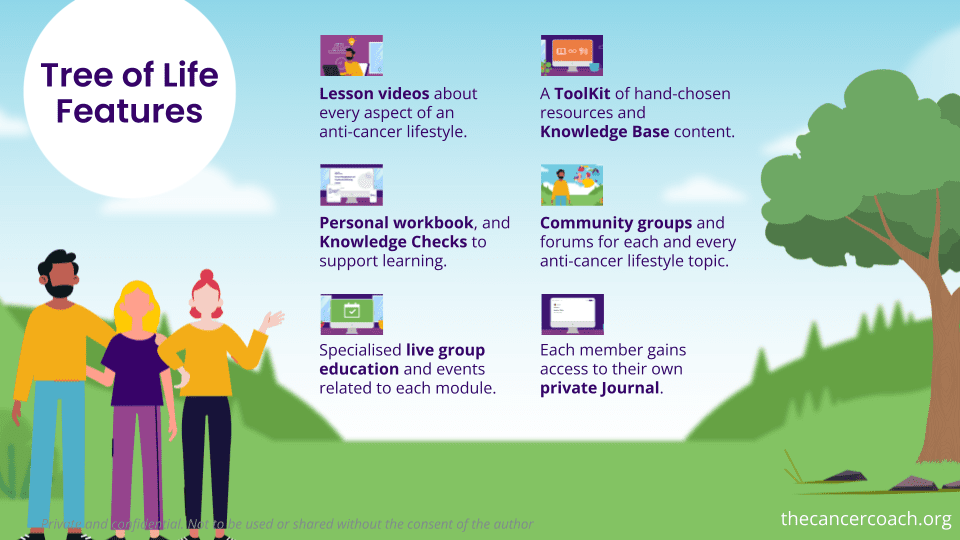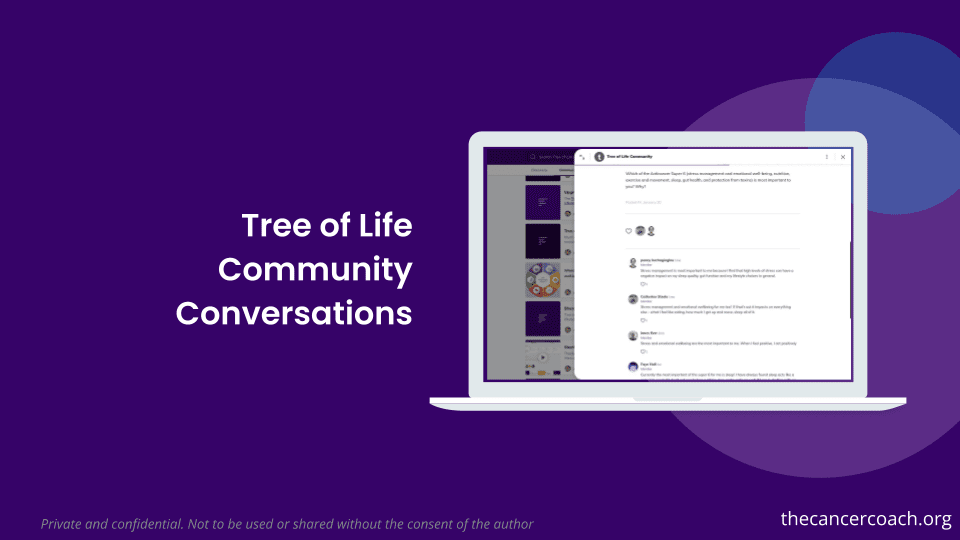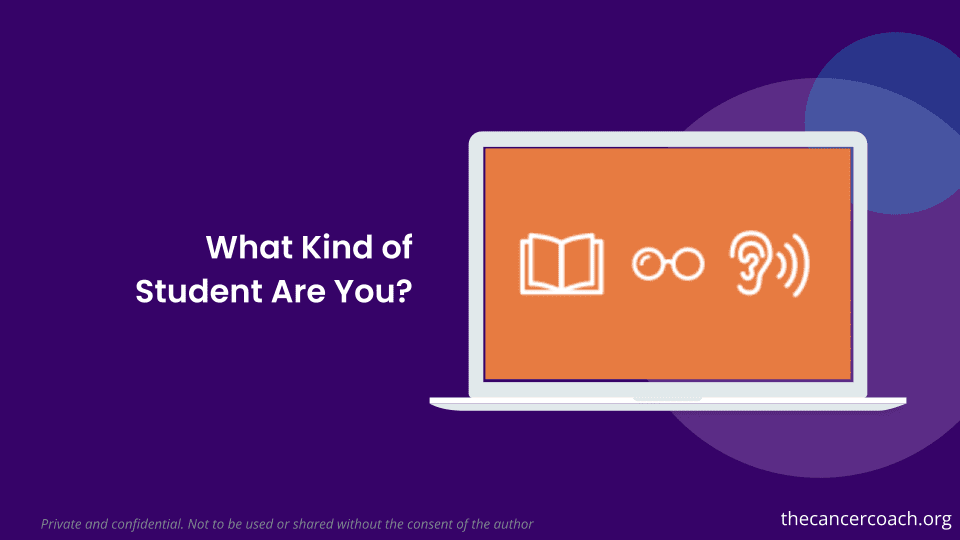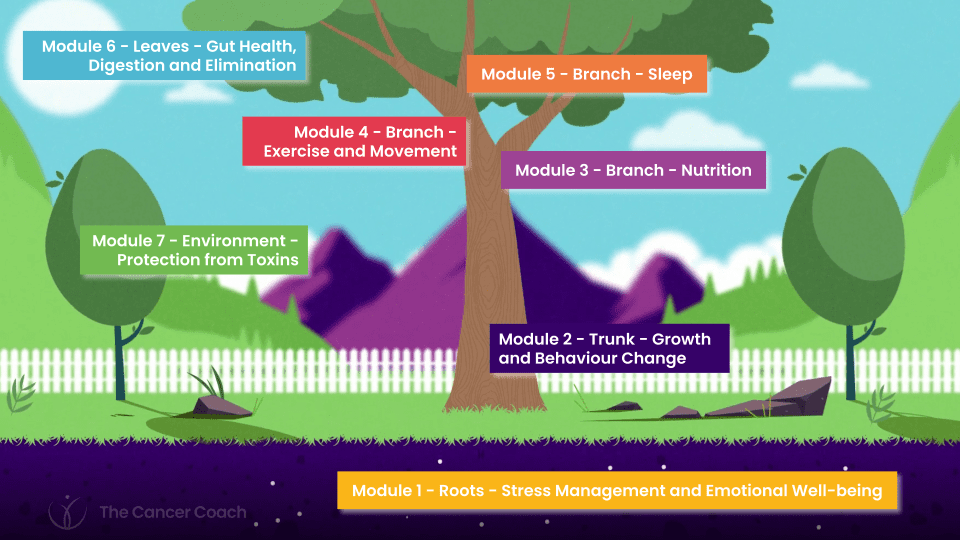Beyond Prevention: A New Era of Employee Wellness and Cancer Defense
Picture this: a workday where everyone is energetic and healthy, and the shadow of cancer isn’t looming over anyone’s head. It’s not just about offering basic health benefits anymore; it’s about truly empowering employees to tackle their biggest health fears head-on
Meet the Tree of Life Program, crafted with expertise by The Cancer Coach. This isn’t just any health plan—it’s a revolutionary approach that transforms how your organization handles health by integrating cutting-edge cancer prevention with comprehensive wellness strategies.
Why not help your employees (or your clients’ employees if you provide employee benefits and hr programs) build a culture that genuinely values health? With Tree of Life, boost workforce engagement and productivity. It’s about more than just surviving; it’s about thriving and providing support in every aspect of health.
Facing the Challenge Head-On
In every workplace, behind the professional achievements, there’s a hidden struggle with health, particularly with cancer, that’s affecting not just individual employees but entire teams. This challenge is deeply personal, affecting their work, their emotional well-being, and the overall workplace atmosphere.
Imagine being in their shoes, trying to stay productive while dealing with cancer treatments, navigating the complex healthcare system, and managing the emotional stress that accompanies the disease. It’s overwhelming, and on top of that, they face an array of legal implications related to disability recognition.
The impact? It’s profound. Every 90 seconds, another employee faces a cancer diagnosis, disrupting not just their life but also your clients’ business operations. The cost is enormous—not just emotionally but financially, with companies facing significant losses in productivity and rising healthcare costs.
What’s desperately needed is not just any health program but a truly comprehensive wellness approach that supports the whole person. Unfortunately, many existing programs fall short. They fail to address the core issues, often providing superficial solutions that leave employees feeling unsupported and vulnerable.
This ongoing gap fosters a pervasive atmosphere of uncertainty. Employers and employees alike are left navigating a confusing array of health programs, all while seeking something genuinely supportive.
It’s Time for a Real Change
Let’s shift the narrative. It’s time to adopt solutions that don’t just make promises but deliver real results. Solutions that truly understand and tackle these challenges head-on, offering not just temporary fixes but genuine, long-lasting support.
Envision a New Standard in Workplace Health
Picture this: a workplace where health thrives and every employee feels fully supported, not just in their careers but in their personal health journeys. What if the looming shadow of cancer was met not with fear but with proactive support and resilience?
A Day of Confidence, Not Dread:
Imagine employees starting each day with confidence, equipped with professional cancer coaching and preventive care. The anxiety once associated with health fears is replaced by a proactive, empowered approach.
Cutting Costs, Not Corners:
Shift away from reactive healthcare that drains finances. With our focus on prevention and early intervention, you (or your clients) can save significantly while reducing the emotional and financial burden of late-stage treatments.
Productivity That Peaks, Not Plummets:
Free the workforce from the distractions of health worries. Watch as engagement and satisfaction soar, transforming everyday productivity from mere survival to vibrant thriving.
Become a Beacon for Top Talent:
Your commitment to employee well-being will set you apart. Draw top talent to your (or your clients’) organization, enhancing reputation as a leader in health and wellness.
A Cultural Shift Toward Comprehensive Care:
Imagine a company culture where well-being is woven into every aspect of corporate life. Every employee feels valued and supported, integral to a community that champions their health.
This vision can be your reality with the Tree of Life Program. More than just a benefits package, it’s a commitment to a healthier, more vibrant future.
Transform Your Workplace Today—Empower Employees with Health and Hope.
Navigating Past Obstacles in Wellness Programs
It’s likely you’ve tried to pave the way to better health at your organization, only to find that not all paths lead to success. Like many others, you might have explored several avenues:
Surface-Level Solutions Like Meditation Apps: Tools like Headspace for Work offer quick fixes to stress but often miss the mark on engaging with deeper personal or complex health challenges, such as cancer support.
One-Size-Fits-All Employee Assistance Programs (EAPs): While aiming to be comprehensive, these often don’t deliver the personalized care needed to effectively manage diverse health issues, leaving employees without the targeted support they need.
Virtual Fitness That Doesn’t Fit All: The allure of digital wellness classes is clear, but their one-size-fits-all approach rarely meets everyone’s needs, especially in a remote setup, and often fails to integrate physical health with serious health conditions.
Financial Wellness Tools That Miss the Bigger Picture: These platforms aim to alleviate the financial stress associated with health issues but can fall short of addressing the interconnected physical and emotional wellness needs of the workforce.
Reflecting on What Hasn’t Worked
These experiences are not just setbacks but valuable lessons that clarify what doesn’t work—impersonal, generic solutions that fail to address the real and varied needs of employees, especially when it comes to critical areas like cancer prevention and mental resilience.
Turning a New Leaf
Armed with these insights, it’s time to move towards a solution that doesn’t just promise but actually delivers. The Tree of Life Program is designed with the understanding that real wellness transformation requires depth, customization, and a commitment to addressing health holistically and proactively. Let’s set a new standard for what wellness in the workplace looks like.
Introducing a Game-Changer in Employee Health: The Tree of Life Program
It’s clear that traditional health programs just aren’t cutting it anymore. They often miss the mark on depth, personalization, and critical health areas like cancer support. That’s why we created the Tree of Life Employee Vitality and Cancer Defense Program—a complete overhaul of how we think about workplace wellness.
Transforming Wellness from the Ground Up:
The Tree of Life isn’t your typical wellness program. It starts where others end, offering not just health checks but a holistic journey into wellness. With targeted cancer coaching, detailed wellness metrics, and strategies that embrace every aspect of health, we’re setting a new standard.
Tailored Health Strategies for Everyone:
We recognize that each employee has unique health needs, which is why our program offers customized paths that cater to everyone—not just the few at risk. Whether it’s managing stress or combating chronic diseases like cancer, we’ve got it covered.
Expert Guidance Every Step of the Way:
Imagine every employee had a health coach to guide them through prevention, management, and recovery. With Tree of Life, that becomes a reality. Our cancer coaches are experts in their fields, offering the support and knowledge needed to make the health journey less daunting and more manageable.

Building Stronger Communities:
Health flourishes in a community setting. That’s why our program focuses on building networks of support among employees, fostering a culture where people can share, learn, and grow together. This isn’t just about individual health; it’s about creating a healthier, more supportive workplace.
Backed by the Best Science Available:
We stand by our methods because they’re proven. Aligned with the latest World Health Organization (WHO) guidelines and backed by extensive research, the Tree of Life is at the cutting edge of preventive health, offering evidence-based strategies to minimize cancer risks effectively.
Step Into the Future of Workplace Wellness:
This isn’t just another program—it’s a movement. Join us in redefining what it means to support employee health with a program that’s as compassionate as it is comprehensive. It’s time for a real change, and it starts with the Tree of Life.
Building on a Decade of Success
A Foundation of Proven Expertise: With ten years of one-on-one cancer coaching experience under our belt, The Cancer Coach has consistently demonstrated effectiveness in supporting individuals through their cancer journeys. Our high Net Positive Score (NPS) of 87%, positioning us in the top 1% of wellness and support programs, attests to the profound impact and satisfaction reported by our clients. This extensive track record forms the robust foundation upon which the Tree of Life Program is built, ensuring that we bring not only new solutions but proven strategies to your organization.
A New Era of Workplace Wellness Innovation:
The Tree of Life Program is the natural evolution of our decade-long expertise in cancer coaching, crafted by leading oncology, lifestyle medicine, and behavioral science experts, alongside invaluable insights from health coaches and cancer survivors. While the Tree of Life itself is a pioneering initiative, its development is deeply rooted in real-world experience and evidence-based practices, making it a uniquely reliable and innovative offering in workplace wellness.
Justification for Early Adoption:
Investing in the Tree of Life Program goes beyond conventional cost considerations—it represents a strategic decision to enhance your organizational wellness culture proactively. The program is designed to align with the holistic wellness trends increasingly demanded by today’s workforce, offering significant ROI through improved employee health, reduced absenteeism, and lower healthcare costs. Moreover, adopting this program early allows your organization to lead in employee wellness innovation, backed by our proven methods and expert design.
Experience and Endorsements:
For providers of employee benefits and hr programs: To ensure you can fully trust in the transformative potential of the Tree of Life Program, we provide Workplace and Employee Benefits Providers’ employees with a complimentary pilot to access the full 7-module program. This not only allows your team to experience the benefits firsthand—including our rich module content and vibrant community—it also equips you with authentic success stories to enhance your credibility when advocating for the program to your customers.
Flexibility and Comprehensive Integration:
Designed for adaptability, the Tree of Life Program seamlessly complements diverse organizational cultures and existing wellness infrastructures. Its flexible nature ensures that it enhances rather than disrupts your current initiatives, providing a comprehensive health management experience that integrates effortlessly with your existing systems.
Proactively Addressing Comprehensive Wellness Needs:
Beyond traditional health measures, the Tree of Life Program integrates physical, mental, and emotional health support, focusing strongly on preventive care and specialized support like professional cancer coaching. This holistic approach fills a crucial gap in typical wellness programs, providing proactive rather than reactive care, and setting a new standard in employee health management.
Changing the Narrative on Cancer in the Workplace:
Leading the way in how cancer is addressed within corporate environments, the Tree of Life Program empowers employees through educational and community-driven initiatives, diminishing the stigma associated with cancer. This proactive approach fosters a supportive work environment that encourages open dialogue and proactive health management, contributing to a healthier, more engaged workforce.
Leveraging Our Legacy to Innovate Your Future:
Our commitment to transforming workplace wellness is not just based on our vision for the future but is anchored in a decade of proven success. The endorsements from partners and users, coupled with our high NPS, underscore the efficacy and transformative potential of the Tree of Life Program, affirming its status as a cutting-edge solution in workplace wellness. Embrace this opportunity to be at the forefront of health innovation, backed by a legacy of success and expert design.
Endorsements from Visionary Partners
Recovre Group’s Industry-First Initiative:
“…World Cancer Day, a perfect moment to launch our Anticancer Lifestyle and Coaching Program in partnership with The Cancer Coach™. This industry-first innovation equips your employees with evidence-based education and access to a supportive community focused on cancer prevention and wellness. Our initial implementation has demonstrated a market-leading improvement in Quality of Life scores in 87% of users.” — Recovre Group Post
Mercer Marsh Benefits’ Praise for Innovation:
“Excited by the innovation and scope of this new model, which allows us to deliver an end-to-end solution across prevention, carer support, and return to health and work.” — Jordan Telfer, Head of Growth & Innovation, Mercer Marsh Benefits
Personal Testimony from Sara Spinks:
“Six years ago, I was diagnosed with cancer, and it was an unknown & very challenging situation. The Tree of Life Employee Vitality and Cancer Defense Program, being the first of its kind in the UK workplace, guides everyone to understand health fundamentals, including cancer prevention. It is comprehensive, evidence-based, and action-oriented, a fundamental necessity for healthy change in the workplace.” — Sara Spinks, Functional Medicine Certified Health Coach, and Cancer Survivor
Dr. Dimple Devadas Validates Our Approach:
“The Tree of Life combines evidence-based Lifestyle Health information, personalized 1:1 Health coaching, and community support with a powerful digital platform. It’s a comprehensive holistic programme that provides trusted information and vital support.” — Dr. Dimple Devadas, Lifestyle Medicine Physician, GP, Psychology Health Coach
From Vision to Reality
As you navigate the complex landscape of employee wellness, it’s clear a unique, holistic solution is essential—not just one that tackles today’s health challenges but one that cultivates a sustainable culture of wellness.
The Tree of Life Employee Vitality and Cancer Defense Program isn’t just another health initiative; it’s a revolutionary journey that meets the evolving needs of modern workplaces with innovative cancer prevention and comprehensive well-being strategies.
Customized Wellness Solutions for Every Organization:
We understand the diversity of workplace environments and challenges. That’s why the Tree of Life Program is meticulously crafted to blend into various organizational cultures effortlessly. Whether operating in traditional offices, remote settings, or a hybrid of both, our program’s adaptable nature ensures every employee reaps its benefits.

Empowering Employees with Expert Care and Community Support:
At the core of Tree of Life is our commitment to empowering employees. By integrating expert cancer coaching and fostering a supportive community, we make achieving health and wellness an accessible and shared goal across all levels of the workforce.

Backed by Science, Endorsed by Pioneers:
The Tree of Life Program is a scientifically grounded, evidence-based initiative that builds on the proven success of our one-on-one cancer coaching. Early feedback from pioneers like Recovre is highly encouraging. These early adopters highlight the program’s potential to significantly enhance workplace quality of life, offering you a promising opportunity to make a meaningful impact.
Embrace the Tree of Life Program:
Imagine a workplace where every employee feels valued and health is a community goal. By choosing the Tree of Life Program, you’re not just adopting a health plan; you’re fostering a transformative culture that prioritizes well-being at every level of the organization.
Invest in more than just health—invest in your success and peace of mind by integrating the Tree of Life Program into your portfolio today.
Empower the Workforce with a Groundbreaking Wellness Solution
The Tree of Life Program transcends traditional health services by embarking on a transformative journey tailored specifically to combat one of today’s most formidable health challenges: cancer. This program is intricately designed to dovetail with existing wellness initiatives, providing a holistic regimen that encompasses mental, physical, and emotional health through its cutting-edge, evidence-based strategies.
What Does the Tree of Life Offer?
Personalized Learning Paths: Recognizing the individuality of each employee, the Tree of Life Program crafts personalized routes through cancer prevention and general health enhancement, ensuring that each journey is distinctively aligned with personal health requirements.

Professional Cancer Coaching: Equipped with expert cancer coaches, the program offers employees robust support, enabling them to effectively understand and reduce cancer risks.
Comprehensive Wellness Modules: Extensive modules cover seven of the essential health topics like stress management, nutrition, and physical activity. Each module is carefully designed to promote healthier lifestyle choices crucial for cancer prevention and support.

Community Support: The program fosters a supportive community environment where participants can connect, share experiences, and encourage one another, significantly enhancing the journey towards health.
Measurable Outcomes: By leveraging data-driven insights, the Tree of Life Program quantifies the health benefits of participation, allowing organizations to visibly appreciate the value of their investment.
Evidence-Based Content: All educational materials within the program are grounded in the latest scientific research, guaranteeing that employees receive the most effective and up-to-date health strategies.
Why Choose the Tree of Life?
Tailored to Diverse Needs: The Tree of Life Program is meticulously crafted to accommodate the varied lifestyles and unique circumstances of employees. Whether they are engaging in preventive measures, navigating personal cancer experiences, supporting a loved one, adhering to specific religious practices, or adjusting to unique living environments, the program’s flexibility ensures that every individual’s needs are met.
A Comprehensive Health Strategy: Excelling in prevention and active support through all cancer phases—from diagnosis to treatment and survivorship—the program also provides crucial support for caregivers. It enhances the ability of individuals to perform in their professional roles, facilitates a smoother return to work, and nurtures a supportive work environment.
Boosting Engagement and Productivity: A healthier workforce is inherently more productive. This program not only promotes physical health but also enhances mental clarity and emotional well-being, thereby elevating overall workplace performance.
A Commitment to Excellence and Impact:
Backed by robust testimonials and real-world evidence, the Tree of Life Program is more than just a service—it is a comprehensive strategy aimed at profoundly enhancing workforce well-being and fostering a positive organizational culture. By choosing this program, you invest not just in a health plan, but in a legacy of health and productivity that reverberates through every level of the organization.
Tree of Life Pricing Structure
The Tree of Life Employee Vitality and Cancer Defense Program offers two flexible pricing options tailored to meet the needs of various organizations, ensuring every employee gains access to this life-changing wellness program. All pricing is structured per user per month in USD, with a commitment to a 12-month term to ensure sustained impact and value.
Free Access for All Members: Every Member in the Tree of Life program enjoys complimentary access to a wealth of resources, including the first module on Stress Management and Emotional Well-being, Curated Learning Experience, a selection of Workbook Exercises, and more. This base level ensures all employees can start their wellness journey with foundational tools and community support.
Full Access for Paid Members: For a comprehensive experience, Paid Memberships unlock the full spectrum of the program’s offerings. This includes all seven modules covering crucial aspects of a healthy lifestyle, extensive educational content, increased community group access, and personalized coaching opportunities. The transition from Free to Paid Membership is seamless, providing a deeper dive into wellness education and personal growth.
Subscription Options:
Option 1 – Paid on Registration: This traditional payment model allows for upfront annual payment for each member account created, offering tiered pricing based on the number of accounts:
Up to 50 accounts at $4.0 USD each
Discounts apply as the number of accounts increases, with substantial savings for larger groups, down to $1.0 USD each for 100,000+ accounts.
Option 2 – Paid on Engagement: A pioneering approach that activates paid subscriptions only when members engage with the program by completing Module 1 and starting Module 2. This model emphasizes our commitment to active participation and meaningful change:
Up to 50 accounts at $6.0 USD each
Similar to Option 1, discounts increase with the number of engaged members, offering rates as low as $1.4 USD each for 100,000+ accounts.
Tree of Life Features and Benefits
Transform Your Approach with Personalized Cancer Coaching: Tailored guidance from professional cancer coaches, where personalized strategies revolutionize workplace health and wellness.
Holistic Wellness Coverage: Experience a comprehensive program that combines stress management, nutrition, and physical activity, creating a lifestyle approach to employee health.
Evidence-based Success: Strategies that are not only grounded in science but have shown significant success in enhancing employee well-being and reducing cancer risks.
Pioneering the Market with Innovation: The Tree of Life Program is a leader in integrating cancer defense with overall employee vitality, making it a first-of-its-kind offering in workplace wellness.
Community Strength: A network where peers motivate and support each other, enriching the collective journey towards better health.
Visible Health Improvements: Witness the tangible benefits of the Tree of Life Program through detailed tracking and reporting tools that showcase the effectiveness of your wellness investments.
Expertly Developed Wellness Modules: Modules meticulously crafted by top health experts, providing your team with precise and actionable health guidance.
Adaptable Learning Paths for Unique Journeys: Every employee’s health journey is distinctive—discover how our program customizes its approach to meet individual needs and learning preferences.
A Comprehensive Approach to Wellness: From prevention to recovery, the Tree of Life Program supports every phase of an employee’s cancer journey, empowering not just the individuals but also their caregivers.
Engagement Through Innovative Education: Content designed to make health education both enlightening and engaging.
Empowerment Through Behavioral Change: See real transformation through community-driven strategies that foster lasting health behaviors.
Endorsements That Matter: Explore the glowing endorsements from health professionals and heartfelt testimonials from those who have experienced the program first-hand, underscoring its potential to reshape workplace wellness.
Scalable Solutions for Every Organization: Whether dealing with small businesses or large corporations, the Tree of Life Program is flexible enough to meet diverse organizational health needs effectively.
Investing in Preventative Health for Cost-Effectiveness: Delve into how proactive health measures can significantly reduce the long-term costs associated with chronic diseases like cancer.
Cultivating a Culture of Comprehensive Health: Elevate the workplace by integrating a program that not only focuses on physical health but also enhances mental and emotional well-being, fostering a culture where holistic health is a priority.
Frequently Asked Questions
Q: What if we don't observe the expected health improvements?
A: While individual outcomes can vary, the Tree of Life Program is engineered to seamlessly blend into your health initiatives and yield measurable improvements. We utilize well-established wellness principles that have consistently facilitated positive health transformations across numerous organizations.
Q: Can the Tree of Life Program be integrated with our existing wellness initiatives?
A: Yes, absolutely! The Tree of Life Program is designed with versatility in mind, perfectly complementing your existing wellness initiatives. It enhances your current efforts by addressing critical gaps, particularly in cancer prevention and comprehensive health support.
Q: How can we accommodate the program if we're concerned about budget constraints?
A: Our pricing options are structured to be flexible, accommodating businesses of all sizes. Our engagement-based pricing model means you’re investing in actual participation, ensuring you get real value from active engagement, not just access.
Our Commitment to You
Evidence-Based Wellness Commitment: Our program is rigorously developed based on the latest scientific research and global health standards, including those from the World Health Organization (WHO). We ensure all strategies and advice are derived from proven, evidence-based practices that significantly enhance health and prevent disease.
Expert-Designed Program Assurance: Led by experts in oncology, lifestyle medicine, and behavioral sciences, and enriched with insights from health coaches and cancer survivors, our program meets the highest standards of wellness and cancer prevention and support. We guarantee professional expertise in its development and continuous refinement.
Guarantee of Measurable Outcomes: We are dedicated to providing clear, measurable results to demonstrate the real benefits of our program. You’ll have access to detailed metrics on engagement and improvements, using internationally recognized evaluation tools to visibly track the effectiveness of your investment in employee health.
Proven Potential and Pioneering Commitment
Anticipating Success Through Early Feedback: The Tree of Life Program has already received positive feedback from leading industry figures. The Recovre Group, for example, is launching our program in their Retire & Thrive Challenge with 10,000 members, focusing on holistic well-being which underscores our program’s potential to significantly enhance physical, mental, and social health.
Jordan Telfer of Mercer Marsh Benefits Heralds a New Era: The anticipation and excitement from Jordan Telfer about our programs underscores our broad scope and innovative approach. Mercer Marsh Benefits’ endorsement of our comprehensive health solution across prevention, carer support, and recovery phases showcases the expected value and adaptability of our offerings.
Investing in a Transformative Health Initiative: By choosing the Tree of Life Program, your organization is not merely adopting a new health plan; you are investing in a pioneering approach that promises significant improvements in quality of life and cost-efficiency in health management. We are fully committed to this journey with you, ensuring that our innovative solutions meet your needs from the outset.
Every Moment Matters
As cancer rates continue to rise and the burden of healthcare costs mounts, the need for comprehensive wellness programs has never been greater. Beyond the numbers and forecasts lies a deeper, personal imperative: the well-being of every employee.
Contemplate the transformative potential of the Tree of Life Employee Vitality and Cancer Defense Program. Envision a workplace where every individual is not merely surviving but thriving, supported by resources that protect their health and enhance their overall quality of life.
What Could Delay Cost You?
The consequences of inaction extend beyond compromised health. They include lost talent, decreased morale, and a corporate culture that falls behind in today’s health-conscious world.
The advantages of being a pioneer are clear—fostering a company culture that values health, boosting employee loyalty, and drastically reducing healthcare costs. These aren’t mere aspirations but tangible results achievable with the Tree of Life program. This initiative not only complements but significantly enhances your existing employee wellness strategies.
Choose Your Path
This moment is a crucial juncture: one path is uncertain and reactive; the other leads to proactive empowerment and a vibrant, healthy organizational culture. By choosing the Tree of Life, you provide your team—or your clients’ teams—more than just defense against illness; you offer them a roadmap to an improved quality of life.
Transform Your Organization’s Approach to Wellness – Secure Your Demo Now
Step forward and differentiate your organization as a frontrunner in employee health and well-being. Submit the form, schedule your demo, and receive your All-Access Pass to the Tree of Life program. Experience firsthand how this pioneering approach can redefine wellness within your company.
